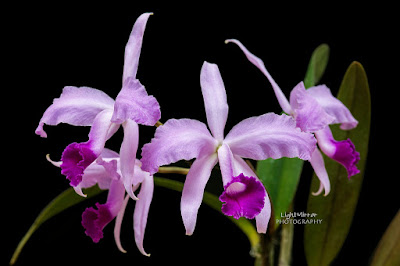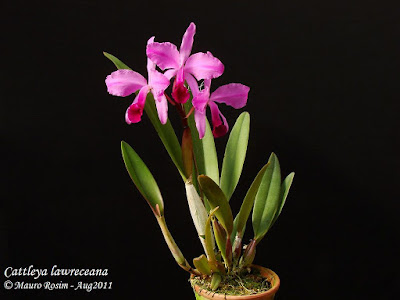Cattleya lawrenceana is found in Venezuela and Guyana. It grows in forested areas, usually near streams or rivers, and are most abundant at elevations around 250 to 1200 meters above sea level.
Cattleya lawrenceana also called as Sir Trevor Lawrence's Cattleya, Cattleya lawrenceana var. concolor, Cattleya lawrenceana var. rosea-superba, is a species of the genus Cattleya. This species was described by Heinrich Gustav Reichenbach in 1885.
IDENTIFY CATTLEYA LAWRENCEANA ORCHID PLANT
Cattleya lawrenceana is found in Venezuela and Guyana. It grows in forested areas, usually near streams or rivers, and are most abundant at elevations around 250 to 1200 meters above sea level.
It is a medium sized, hot to cool growing epiphyte with erect, clavate, sulcate, compressed, green to purplish green pseudobulbs subtended by several persistent white sheaths and carrying a single, apical, oblong-ligulate, thick, rigid, obtuse, green with purple spotting leaf.
Sir Trevor Lawrence's Cattleya blooms in the spring and early summer on a usually erect, 10 cm long, terminal, racemose, 5 to 8 flowered inflorescence subtended by a broad brownish-purple spathe. The flowers have lilac sepals and petals, the latter being twice the width of the former. Lip tube-like, with spreading front coloured rosy-purple with white throat.
CATTLEYA LAWRENCEANA ORCHID PLANT CARE AND CULTURE
Cultural information should only be used as a guide, and should be to be adapted to suit you. Your physical location; where you grow your plants, how much time you have to devote to their care, and many other factors, will need to be taken into account. Only then can you decide on the cultural methods that best suit you and your plants.
Light:
Cattleya lawrenceana needs a light level of 20000-35000 lux. Strong air movement should be ensured all the time. No Cattleya will grow sturdily and bloom satisfactorily unless it is grown in a place where it has good light at all times. If you grow them under glass, you should hang them so that they are as close to the glass as you can get them without scorching the leaves and even a little mild sunburn does not seem to do the plants any lasting harm, and, moreover, it appears to encourage them to flower.
Temperature:
The temperature should maintain a high, uniform throughout the year, with daily indications around 29 ° C. At night the temperature should drop to 21 ° C. The daily amplitude is 7-9 ° C throughout the year. Temperature is important for plants because it directly affects the growth of plants.
Humidity:
Sir Trevor Lawrence's Cattleya need the humidity of 70-80% throughout the year. Too dry air has a negative effect on the development of the plant: its growth is inhibited, and the leaves begin to turn yellow and dry out. The higher temperature, the higher the humidity should be, and the higher the humidity, the more often and longer it is necessary to ventilate the room where the plants are contained, otherwise the probability of rotting and various kinds of fungal diseases.
Substrate, growing media and repotting:
Cattleya lawrenceana are usually grow well attached to pieces of tree fern or cork, but this requires high humidity, and in the summer of daily watering. In the period of extremely hot and dry weather, attached plants may require even several waterings during the day. These plants can also be grown in pots or baskets filled with a very thick, loose, quickly drying base that allows the roots to dry quickly after watering (osmunda fibre, sphagnum moss, todea, polypodium fibre and staghorn peat mixed with large lumps of charcoal). It is recommended to use smaller pots sufficient for 1-2 years growth, because the substrate in larger pots stays wet for too long after watering. The result of insufficient quick-drying roots can be their rotting.
Repotting or dividing plants should be done when the growth of new roots begins. This will enable the plant to root in the shortest possible time and avoid weakening. In the event of a violation at the wrong time, many of the two-leafed Cattleya will remain stagnant and eventually die.
Watering:
The state of the air about the plants is a large factor in deciding when and how much to water them. When dry, hot winds are prevalent, frequent and copious waterings will be necessary. On dull days or days when moisture laden winds affect the air, little or no water should be given. On clear, bright sunny days, again, you will need to give your plants a good drenching early in the morning. When it is raining outside the house there is no need for water inside - even if the glass keeps out the actual rain, the air will carry water, which will be absorbed by the plants. When watering, excess water should flow freely from the pot, since stagnation of water both inside the pot and in its pan can very quickly lead to rotting of the roots and the lower part of the plant.
A plant on a block or raft can stand practically unlimited water, as the surplus runs off or evaporates very quickly. Baskets also allow very quick drainage, and so can stand liberal water. Pots tend to retain the water, so that a potted plant needs less frequent watering than a basket one. If a pot has its drainage properly arranged so as to allow free exit of surplus water, the plant in it can stand more frequent watering than when the drainage is placed flat in the pot covering the drainage hole.
Fertilizer:
During the active growth of the plant should be fertilized every week 1/4-1/2 of the recommended dose of fertilizer for orchids. A fertilizer with a high nitrogen content is beneficial from spring to mid-summer, and a phosphorus-rich fertilizer can be used in late summer and autumn.
To prevent the accumulation of mineral deposits, the amount of water equal to 1/10 the volume of the pot must flow freely through the pot at each watering. In order to remove previously accumulated salts, it is necessary to rinse the pot well every 3-4 weeks before next fertilization. First you should normally water the plant and leave the pot for about 30 minutes. The accumulated salts will dissolve during this time. Then rinse the pot once more with clean water in an amount corresponding to the double volume of the pot.
Rest period:
In tropical regions, where conditions prevail throughout the year, the resting period can be very short. In winter, you can simulate these conditions by decent watering every few weeks along with weak fogging every few days. Fertilization should also be lowered and used every 2-3 weeks if the plant is not in the active growth phase.















COMMENTS